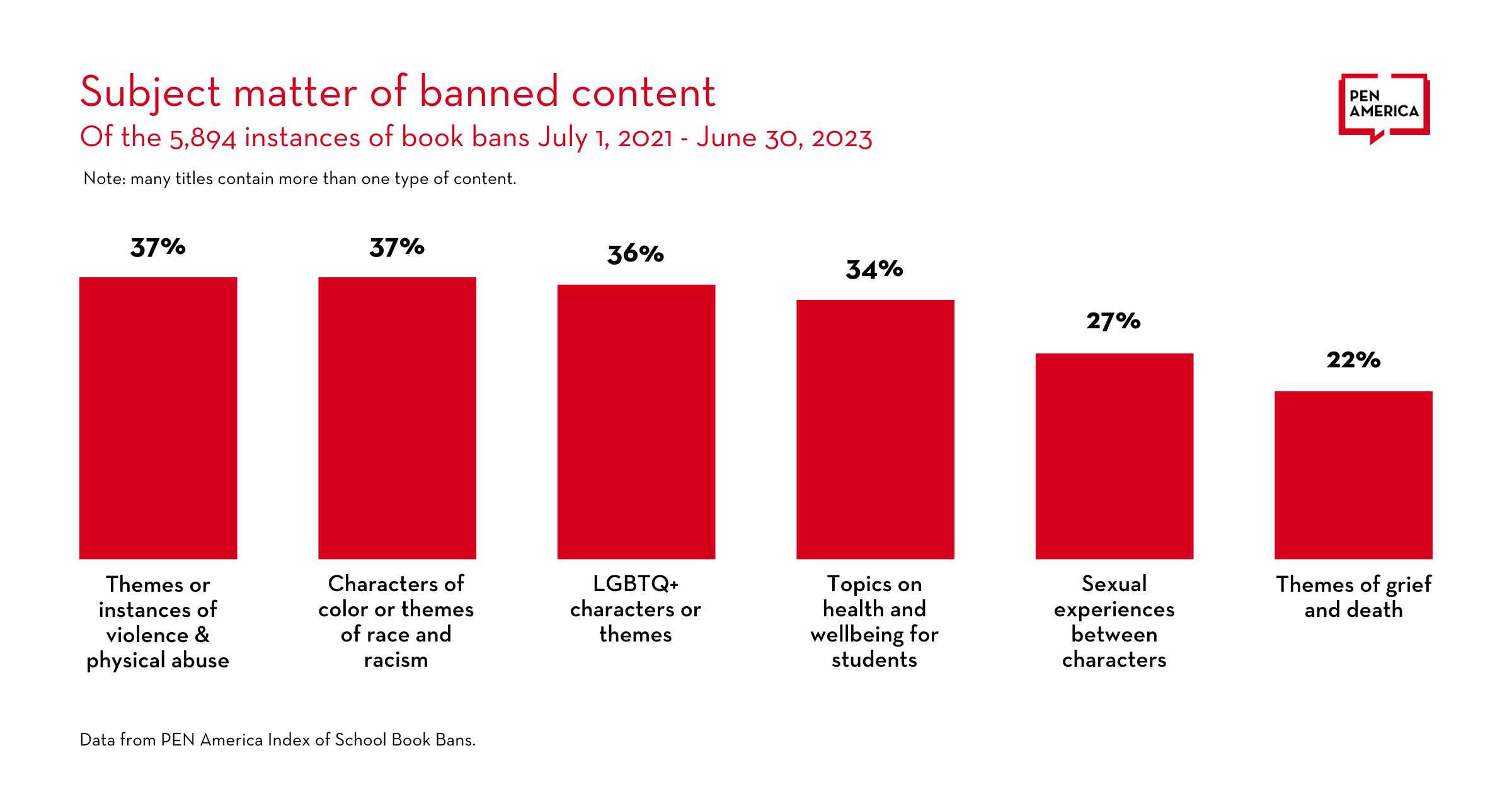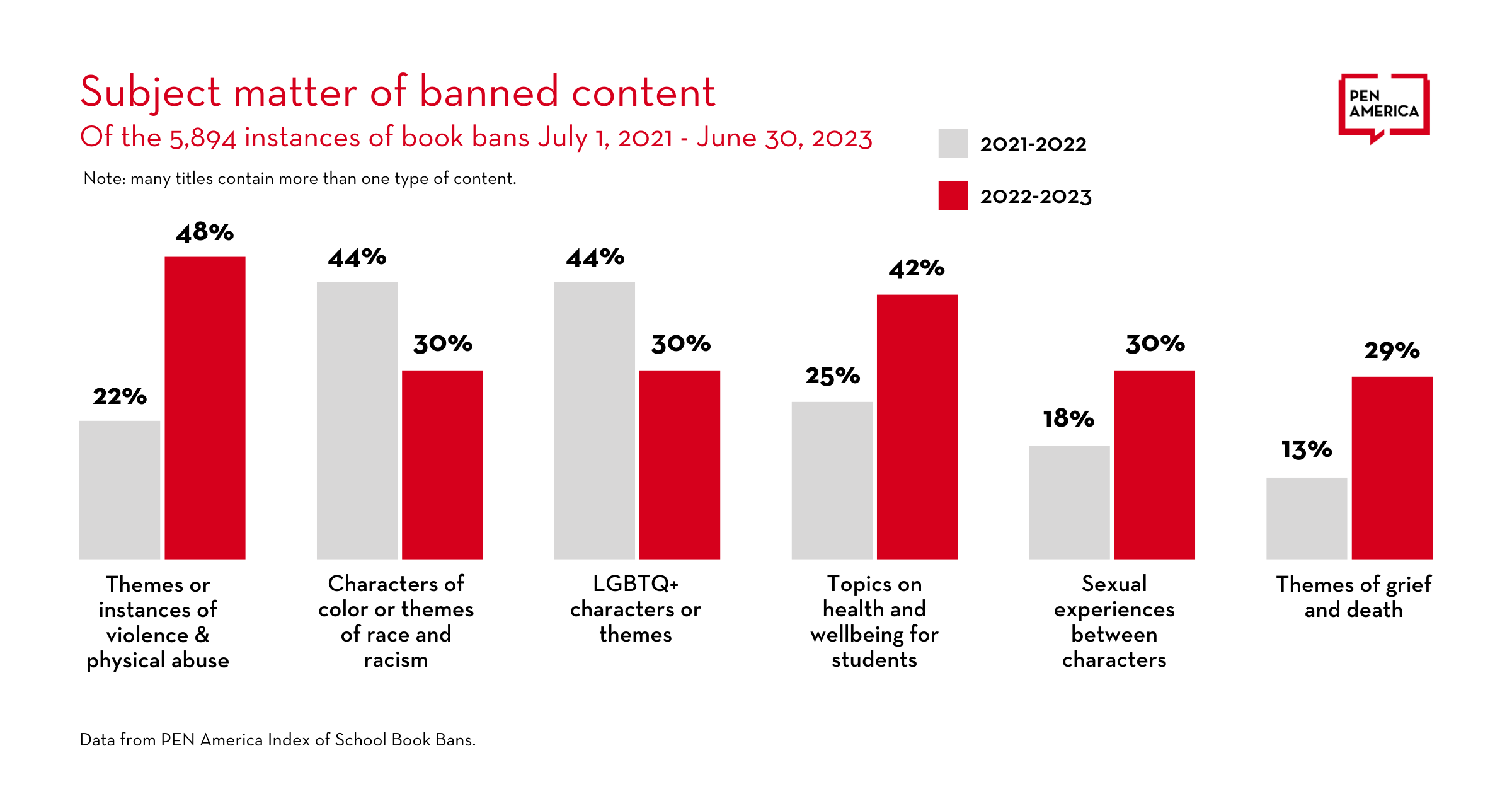
PEN Experts
PEN America Needs Your Help.
Join us to #FreeTheBooks by taking action and making your voice heard.
Download the Index Data:
A July 2021 to June 2023 Cumulative Data Summary
The last two years have shown an undeniable and unprecedented attack on free expression in public education.
As 2023 comes to a close, the following data summary examines the insidious trend of book banning in public schools over the last two academic years, drawing from data collected in PEN America’s Index of School Book Bans.
Key Takeaways
- The past two school years have demonstrated a mounting crisis of book bans. From July 2021 to June 2023, PEN America’s Index of School Book Bans recorded 5,894 instances of book bans across 41 states and 247 public school districts.
- “Copycat bans” have emerged as a key component of the book ban movement, with a portion of titles removed seemingly because another district removed it elsewhere.
- Relatedly, some authors have faced a “Scarlet Letter” effect, where several works from an author’s collection were subsequently targeted after at least one of their works was banned.
- There has been a sustained focus on banning books written for young adults, especially when those books are about “difficult topics” – like violence and racism – or include historically marginalized identities – mainly, people of color and LGBTQ+ individuals.
- Florida and Texas have continued to lead the country in number of bans, but the crisis has spread to 41 states.
- A significant increase in the number of books “banned from classrooms and libraries” indicates that not only have there been more bans, but the bans themselves have been more comprehensive and potentially more permanent.
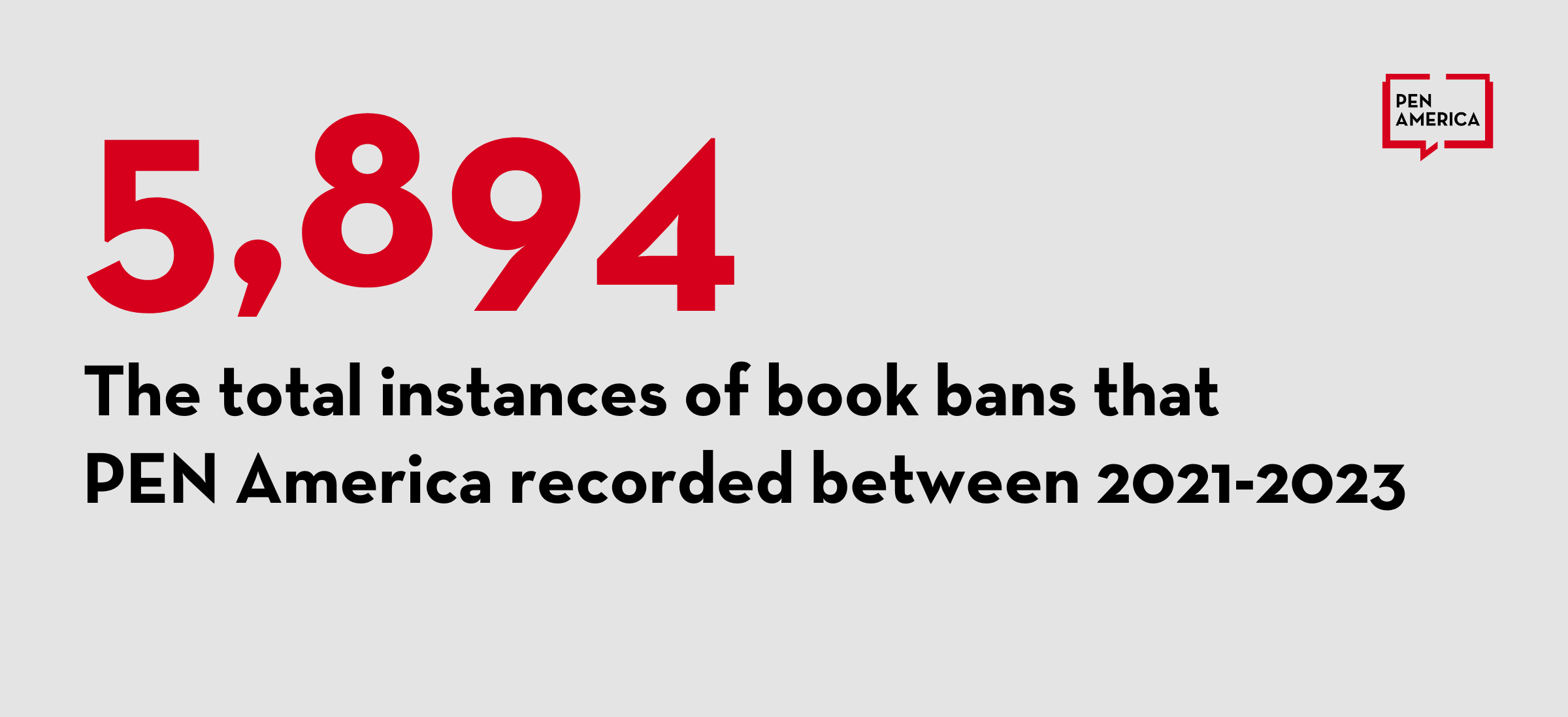
What is a ban?
PEN America defines a school book ban as any action taken against a book based on its content and as a result of parent or community challenges, administrative decisions, or in response to direct or threatened action by lawmakers or other governmental officials, that leads to a previously accessible book being either completely removed from availability to students, or where access to a book is restricted or diminished. Diminished access is a form of censorship and has educational implications that extend beyond a title’s removal.
When It Rains, It Pours: More Bans, More Creatives Impacted, More Books Out of Students’ Hands
From July 2021 to June 2023, PEN America’s Index of School Book Bans recorded 5,894 instances of book bans across 41 states and 247 public school districts. The mounting book ban crisis from the last two school years has affected 2,823 unique titles, censoring the works of 2,076 authors, 517 illustrators, and 31 translators. In sum, book banning has censored a total of 2,598 creatives.
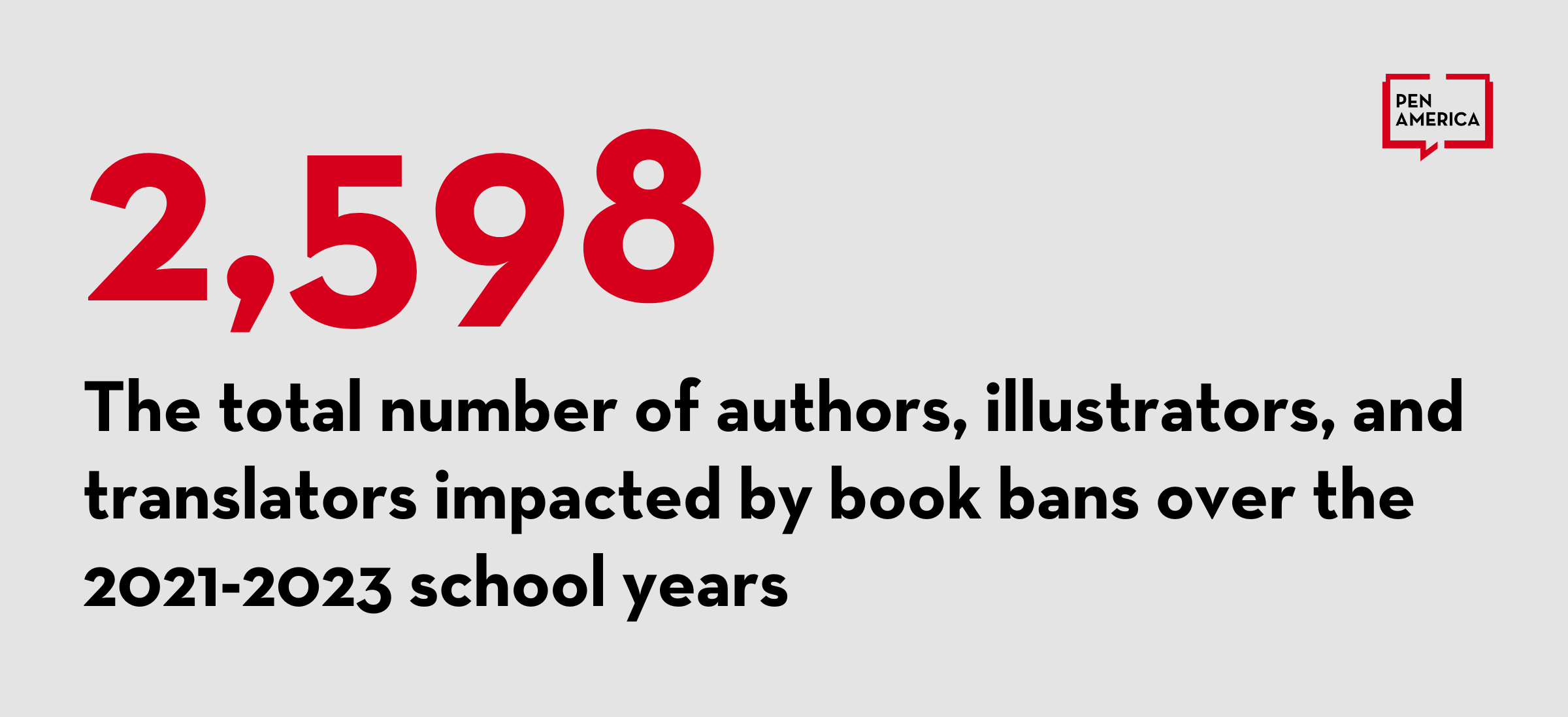
Comparing the 2021-2022 school year and the 2022-2023 school year, instances of banning increased by 33 percent, from 2,532 instances of book bans to 3,362. As noted in PEN America’s 2022-2023 Banned in the USA report, punitive state laws, coupled with pressure from vocal citizens and local and national groups, have significantly contributed to the rise in book bans.
Our data suggests that book banners narrowed their focus on specific books during this time. Despite the increase in total instances of bans, the unique titles implicated in book bans decreased slightly from 1,643 in 2021-2022 to 1,557 in 2022-2023, a decrease of five percent.
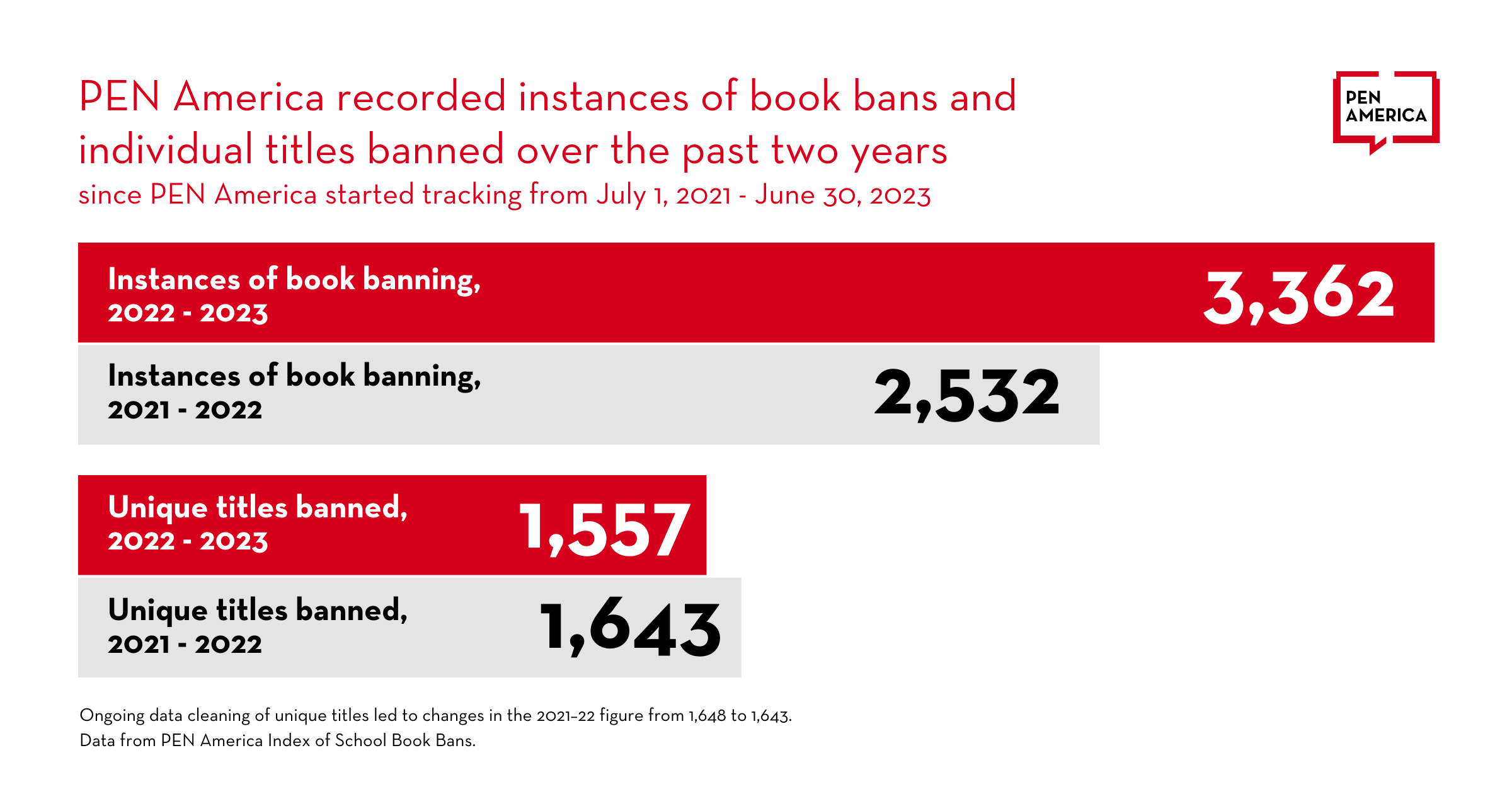
Sweeping the Board: An Increase in Books Removed from Classrooms and Libraries
PEN America tracks four types of school book bans: bans from school libraries, bans from classrooms, bans from both libraries and classrooms, and bans that are pending investigation. For a detailed explanation of each type of book ban, visit our School Book Ban FAQ.
The most severe category of ban, banned from libraries and classrooms, showed a significant increase from year to year. Books banned from libraries and classrooms differ from other types of bans in that they are decidedly removed and inaccessible indefinitely. A school and/or district made the choice to remove the book completely from its collection. In the first school year, 333 bans (13% of all bans that year) fell under this category; in 2022-23, this increased to 1,263 bans or 38%. In total since 2021, 1,596 instances (27%) recorded by PEN America were books banned from libraries and classrooms.
This dramatic increase reflects how the book banning movement is not only growing in total number of bans, but intensifying its efforts to ensure that the bans entirely erase books from schools. The increase is likely due to a range of factors, including districts revising their policies to prohibit certain types of content, district decisions overriding standard processes, and districts responding to state legislation.
Titles in the category, banned pending investigation, recorded a year-to-year decrease by percentage, from 1,375 (54%) in 2021-2022 to 1,466 (44%) in 2022-2023. Across both school years, 2,841 instances (48%) were classified as banned pending investigation. These are instances where a title was removed during a review to determine what restrictions, if any, to implement on it. Books banned in this manner can remain off shelves and inaccessible to students for long periods of time before they are evaluated, as seen with the 97 books challenged in October 2022 in Beaufort County School District, South Carolina, that were immediately pulled from access pending review.
Book bans classified as banned from libraries are titles that have been removed from school libraries where they were previously available. This category showed a less significant change from year-to-year. Overall, 941 book ban instances (16%) from 2021-2023 were banned from libraries.
Banned from classrooms also decreased between the 2021-2022 and 2022-2023 school years, from 487 (19%) to 29 (>1%) book ban instances. Banned from classrooms represents cases where individual titles have been barred from classroom libraries, curriculum, or optional reading lists but may still exist in the school library.
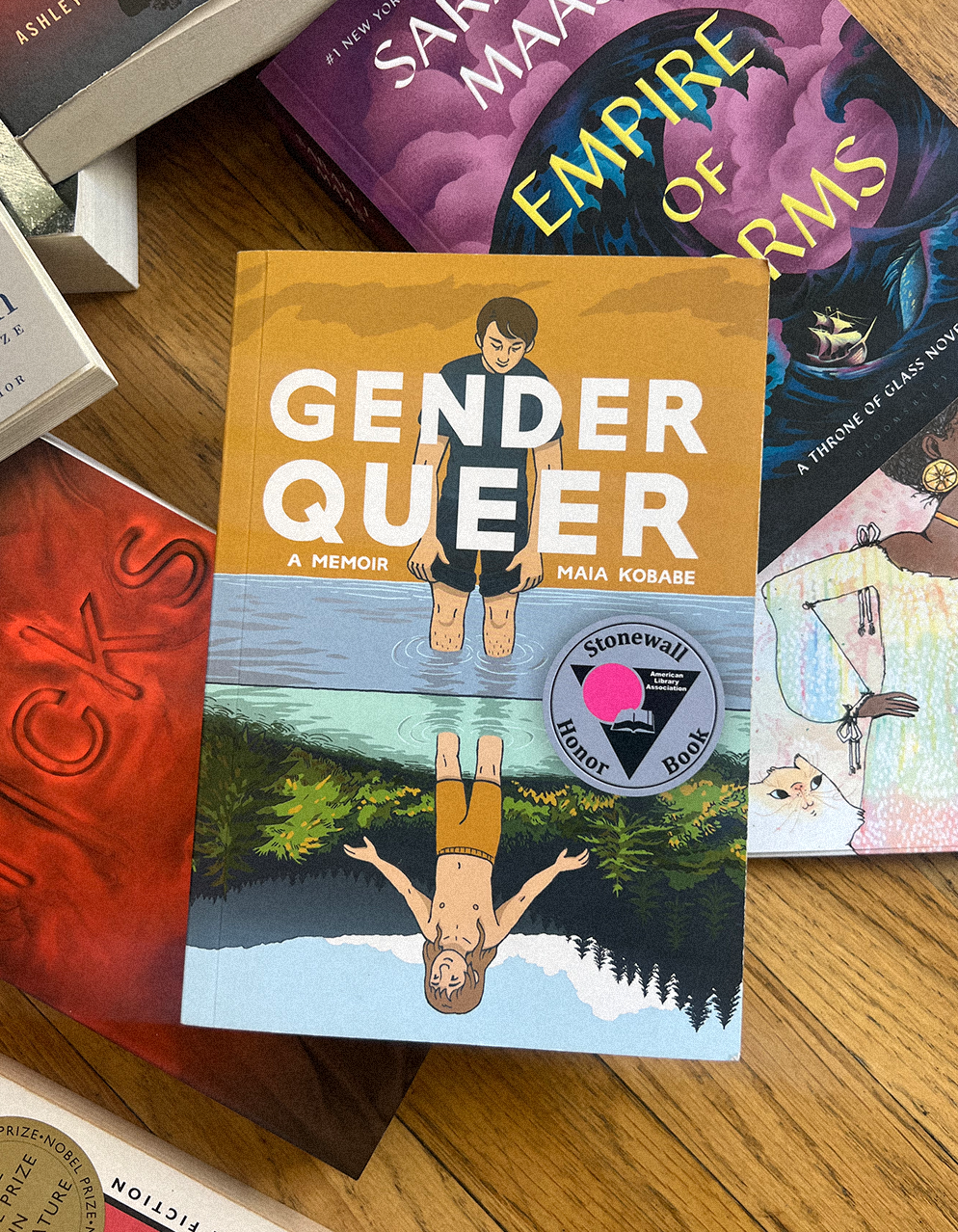
(NOT) THE SAME OLD STORY: HOW COPYCAT BANS SWEEP A WIDE VARIETY OF BOOKS
Titles detailing a wide variety of themes and identities have been targeted at different points within this censorial movement. The most banned books include titles targeted since the beginning of the movement, such as Gender Queer by Maia Kobabe, as well as titles that had previously received less of the censors’ attention, such as Sold by Patricia McCormick and Push by Sapphire.
Gender Queer recorded 41 instances of bans in the 2021-2022 school year and 26 instances of bans in 2022-2023, for a two-year total of 67 total bans. Conversely, Sold by Patricia McCormick was banned in seven districts in the 2021-2022 school year and then in 24 in 2022-2023, bringing the two-year total to 31 bans. Push by Sapphire was only banned once in 2021-2022, but was banned 20 times in 2022-2023, resulting in 21 bans over the two years.
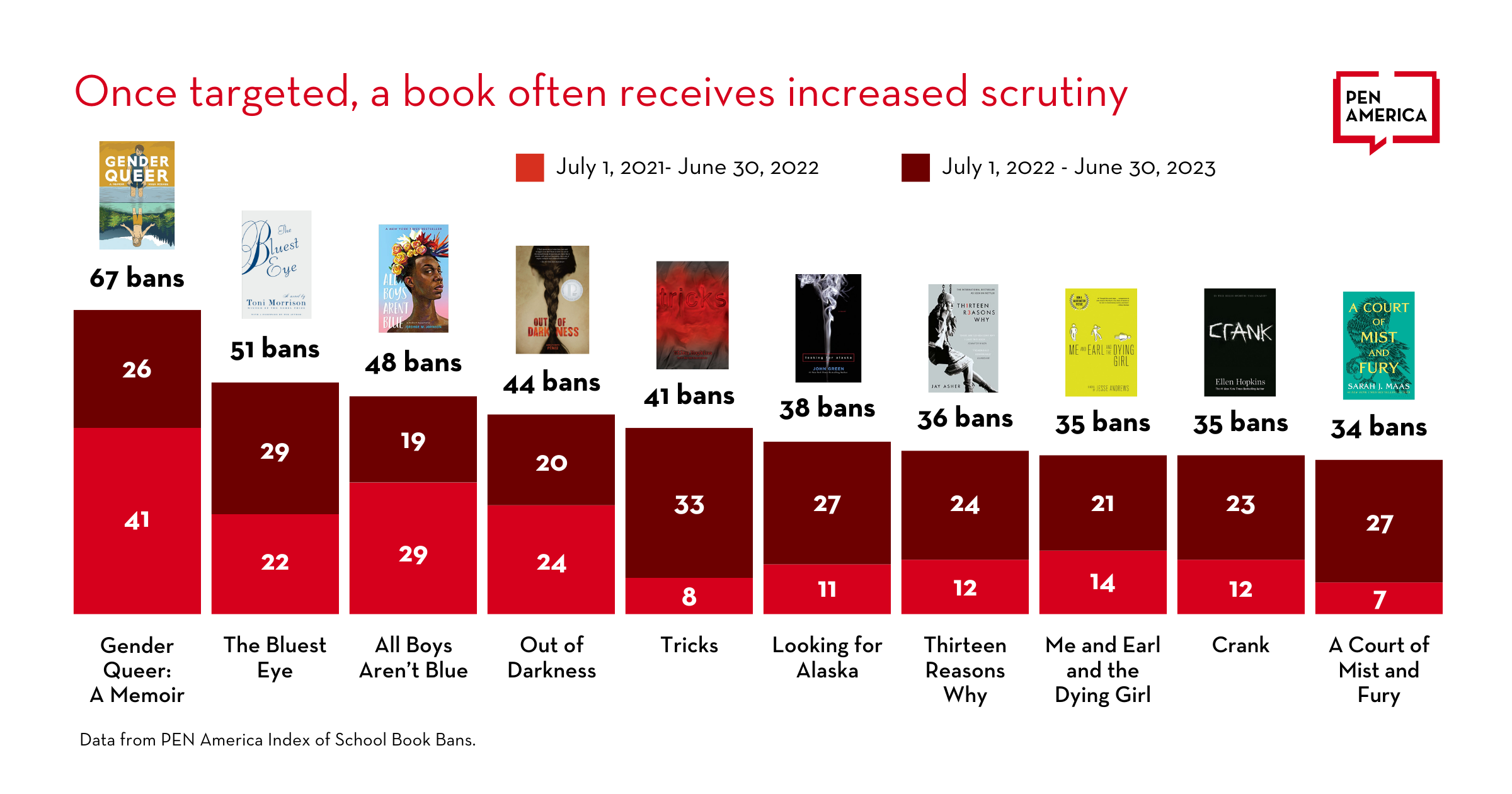
Many times, the volume of bans a book experiences has little to do with its content, but its status as a banned book somewhere in the country. Take Seminole County Public Schools in Florida where the school district reportedly discontinued the use of 31 titles from its library collections based on a list of books that other Florida school districts received complaints over. A book’s status as a banned book is enough to inspire copycats in other school districts, with little attention given to the book itself.
The top three banned authors, Ellen Hopkins, Maia Kobabe, and Toni Morrison, have penned works encompassing a range of genres, themes, and identities. Their works include verse and graphic novels as well as stories that grapple with racism or the exploration of gender identity and sexuality. However, one thing they all have in common is all three authors have been banned in at least 20% of the school districts tracked by PEN America’s School Book Ban Index since July 2021.
| Author | Number of districts that banned author’s work | Total instances of book bans | Total number of unique titles |
|
Hopkins, Ellen |
68 |
268 |
19 |
|
Kobabe, Maia |
65 |
67 |
1 |
|
Morrison, Toni |
55 |
81 |
6 |
|
Johnson, George M. |
47 |
49 |
2 |
|
Maas, Sarah J. |
45 |
176 |
16 |
|
Atwood, Margaret |
44 |
67 |
5 |
|
Andrews, Jesse |
44 |
51 |
2 |
|
Pérez, Ashley Hope |
42 |
44 |
1 |
|
Green, John |
42 |
46 |
5 |
|
Myracle, Lauren |
35 |
71 |
11 |
|
Asher, Jay |
35 |
36 |
1 |
Scarlet Letters: Increased Scrutiny on Previously Banned Authors
For authors who have penned multiple titles, their catalog is likely to be targeted after at least one of their works is banned. Authors are marked with a “Scarlet Letter” that impacts their reputation and leaves schools wary of carrying any of their titles, even ones whose content previously inspired little controversy.
The popular fantasy author Sarah J. Maas is the clearest example. From 2021-2022 to 2022-2023, her total number of unique titles banned doubled from eight to 16. Those titles also attracted increased scrutiny, growing from 18 bans in 10 districts in 2021-2022 to 158 bans in 36 districts in 2022-2023. That represents a 778% increase in the total number of bans. Other authors, like Ellen Hopkins, Jodi Picoult, Alice Oseman, Laurie Halse Anderson, and Rupi Kaur, among others, have felt the “Scarlet Letter” effect as a ban on at least one title is followed by bans across their oeuvre.
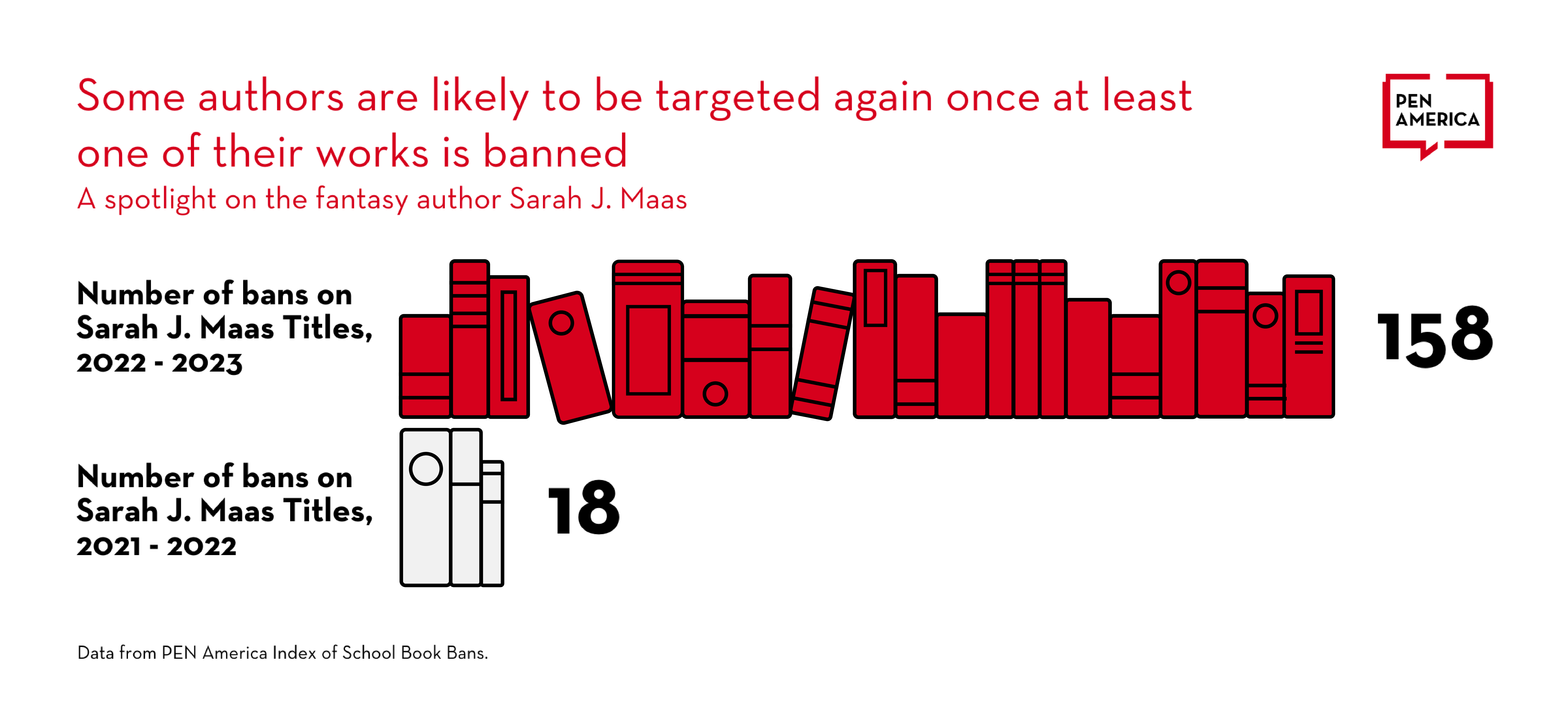
Past the Cover Story: Heightened Scrutiny on ‘Difficult Concepts’ and Diverse Literature
When we examine the scope of the last two years, books that include diverse characters, primarily characters of color, and LGBTQ+ characters, were overwhelmingly subject to book bans. In addition, over a third of all books removed since 2021 include instances of violence and physical abuse, which include books depicting sexual assault.
Note: Numerous books tracked in the Index fit into multiple categories simultaneously. Further, categories appearing in less than 15 percent of instances in the 2021-2023 Index are not reported here; these categories are developed based on researchers’ assessment of books, publisher summaries, Amazon Books, Goodreads, and expert opinions of librarians.
Further, while the book ban movement initially focused on removing “critical race theory” and “divisive concepts” in 2021, this past year saw heightened attacks on books that discuss sexual orientation, gender identity, and sexual experiences as well as “unconformable topics” like sexual wellbeing, violence, abuse, grief, and death. When included in young adult literature, these “difficult concepts” prove essential in helping readers understand themselves and the world around them.
One for the Ages: A Clear Attack on Young Adult Literature
From year to year, young adult books are most targeted. Books written for a young adult grade level made up 55% of the bans in 2021-2022, increasing slightly to 61% in 2022-2023. Overall, young adult books encompassed 58% of all book bans.
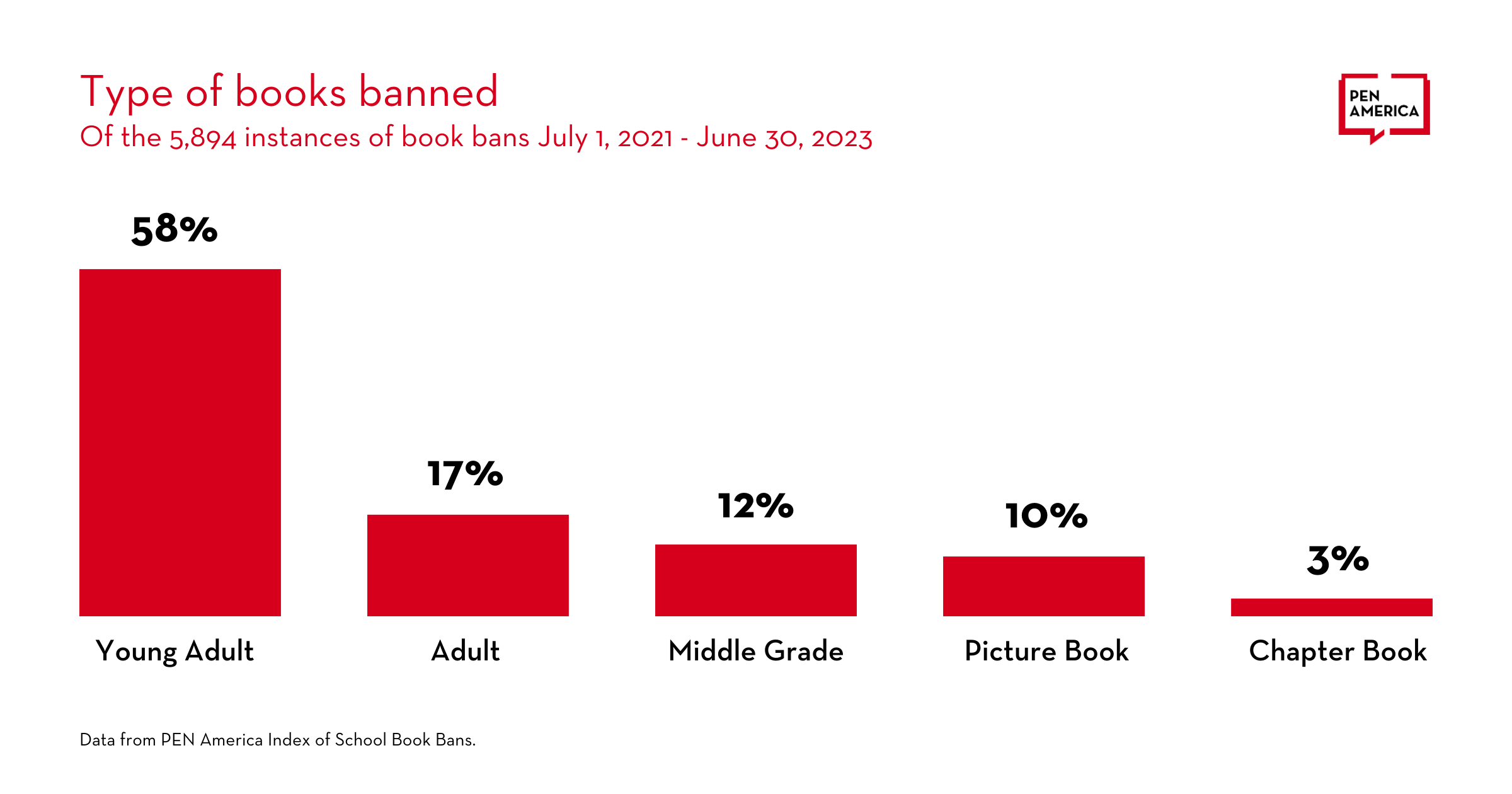
Adult books also showed an increase across instances of book bans, from 12% in 2021-2022 to 22% in 2022-2023, making up 17% of all book bans the past two years. The availability of these books in school libraries has raised heated discussion on the “appropriateness” of adult novels and their place in school library collections. Banned books include “adult” titles like George Orwell’s 1984, Toni Morrison’s The Bluest Eye, and Khaled Hosseini’s The Kite Runner, all of which are critical additions to high school libraries and curricula.
The proportion of banned books written as middle grade, chapter books, and picture book books all decreased slightly from 2021 to 2023.
Overall, since 2021, 83% of book ban instances concerned books that were written for young adult or younger audiences. While the banning movement promotes misleading rhetoric that books are “pornographic” and cause “indoctrination,” the reality is that these books are written with school-age students in mind as both educational and empowering resources, even when they detail difficult experiences.
|
“I think a lot of teenagers find in the book a little bit of a roadmap for how they can find the courage to speak up when a bad thing happens. Too often, bad things happen to our children,” said Laurie Halse Anderson, the author of the young adult novel Speak, a National Book Award finalist that tells the story of a high school student who stops speaking after a sexual assault. “They think they’re shielding their children; what they’re actually doing is they’re making their children more vulnerable,” Halse said. “And they’re making all the kids in their community more vulnerable, despite the wishes of other families.” Speak has been banned 15 times since 2021. |
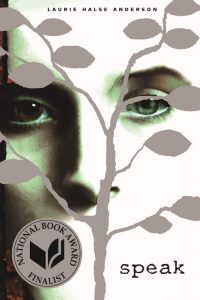
Here, There, and Everywhere: Majority of States Report Book Bans But Florida and Texas Are Top of List
Across the country, 41 states and 247 school districts have been impacted by book bans since July 2021, affecting millions of students.
Total Instances of Book Bans by State, July 2021 - June 2023
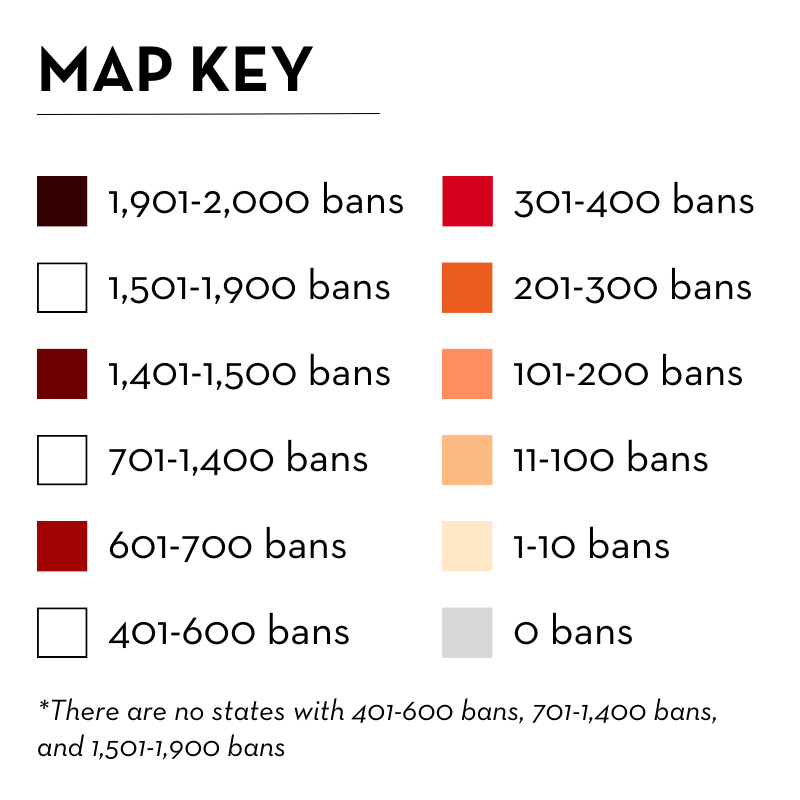
Year-to-year, Florida showed an 148% increase in instances of book bans, from 566 instances in 2021-2022 to 1,406 instances in 2022-2023. The total number of districts impacted by bans also grew from 21 districts in 2021-2022 to 33 districts in 2022-2023. Unsurprisingly, Florida topped the list of total bans across both school years with 1,972 instances of bans in 37 districts. In a state with approximately 70 districts, this means that over half of all Florida school districts experienced banning activity.
Texas reported the most bans in 2021-2022 with 801 bans in 22 districts, and fell second to Florida in 2022-2023 with 625 bans in 12 districts. Overall, the state reported 1,426 instances of bans in 28 districts across 2021-2023.
Florida and Texas far outstripped the rest of the country, accounting for 34% and 24%, respectively, of the total recorded number of school book bans over the last two years.
Five other states experienced at least 100 book bans over the last two school years. Pennsylvania reported 644 instances of bans across 16 districts, followed by Missouri with 360 instances of bans across 16 districts, Tennessee with 360 instances of bans across 9 districts, Utah with 293 instances of bans across 10 districts and South Carolina with 128 bans across 7 districts.
| State | Instances | Districts |
|
Florida |
1972 |
37 |
|
Texas |
1426 |
28 |
|
Pennsylvania |
644 |
16 |
|
Missouri |
360 |
16 |
|
Tennessee |
360 |
9 |
|
Utah |
293 |
10 |
|
South Carolina |
128 |
7 |
Read You Loud and Clear: Uplifting Our Stories and Ourselves
Time and time again, the last two school years keep telling the same story.
Instances of book bans continue to increase in scope and location, with bans taking place in a majority of states. Best practices and procedures are being ignored, facilitating copycat bans across district lines; at the same time, more and more districts are opting for severe bans impacting classrooms and libraries. A “Scarlet Letter” effect makes it so several works by a given author are likely to be targeted once one of their works is banned, and young adult books remain popular targets.
Increasingly, schools and their librarians have been stripped of the responsibility to determine the availability of reading materials in their schools. Just this month, Florida’s Attorney General stated that public school libraries are “a forum for government speech,” not a “forum for free expression.” Such justifications for censorship undermine the point of public education: to teach students not what to think of the world but how to think for themselves.
Despite this culture of censorship, 92% of parents, grandparents, and guardians trust librarians to curate appropriate books and materials, including making recommendations for their children. Many school districts are following their book challenge procedures and ultimately keeping books on shelves. Countless student groups, such as the Panther Anti-Racist Union in Pennsylvania and the Diversity Awareness Youth Literacy Organization in South Carolina, have been vocal in their opposition to book bans in their districts. And not only that, but successful in reversing bans.
Books are an accessible and vital means of sharing viewpoints and worlds. When they are vilified to the point where the knowledge they provide is confused with “indoctrination,” the core principles of public education and the freedom to read, learn, and think are in jeopardy. Education, at every age and every level, requires the inclusion of diverse viewpoints and experiences. Limiting the availability of materials based on ideological complaints has always been, and will always be, censorship. And censorship – even if it’s only affecting one school, one classroom, one student – requires vocal and strong opposition.
Loving books isn’t an unpopular opinion.
It’s time the book banners hear the majority they’re so desperately trying to silence.
Acknowledgments
This data summary was written by Sabrina Baêta, program manager, Freedom to Read. The findings of the project rely heavily on the support and expertise of the Freedom to Read Program team: Kasey Meehan, director; Tasslyn Magnusson, PhD, senior consultant; and Madison Markham, assistant. The research draws from PEN America’s Banned in the USA school book bans reports and annual Index of School Book Bans.
Editorial and strategic support throughout the process was provided by Sam LaFrance, manager of editorial projects, Free Expression and Education Programs. Lisa Tolin, editorial director, and Jonathan Friedman, director, Free Expression and Education Programs, reviewed and edited the project. Suzanne Trimel, senior advisor, Communications and Media, provided communications framing and support.
Finally, we extend our gratitude to the many authors, teachers, librarians, parents, students, and citizens who are fighting book bans, speaking out in their communities, and raising attention to these issues. We are proud to stand with you in defending the freedom to read.


